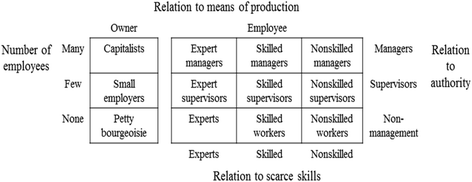Neo-Marxian social class inequalities in self-rated health among the employed in South Korea: the role of material, behavioral, psychosocial, and workplace environmental factors
- PMID: 28427359
- PMCID: PMC5397726
- DOI: 10.1186/s12889-017-4269-9
Neo-Marxian social class inequalities in self-rated health among the employed in South Korea: the role of material, behavioral, psychosocial, and workplace environmental factors
Abstract
Background: The aim of this study was to examine the pattern of social inequality in self-rated health among the employed using the Wright's social class location indicator, and to assess the roles of material, behavioral, psychosocial, and workplace environmental factors as mediating factors in explaining the social class inequality in self-rated health in South Korea.
Methods: This study used data from the 4th Korea National Health and Nutrition Examination Survey from 2007 to 2009. Study subjects included the employed population of 4392 men and 3309 women aged 19-64 years. Subjects were classified into twelve social class positions based on the Wright's social class map. The health outcome was self-rated health. Material, psychosocial, behavioral, and workplace environmental factors were considered as potential mediators in explaining social class health inequality. We calculated prevalence ratios of poor self-rated health according to social class, adjusted for age and mediating factors using Poisson regression models.
Results: Nonskilled workers and petty bourgeoisie reported worse self-rated health than other social classes among men. The age-adjusted prevalence of petty bourgeoisie and nonskilled workers were about four-fold greater than that of managers. Expert supervisors in the contradictory class location had a greater prevalence of poor self-rated health than experts in men. In women, the prevalence of poor self-rated health was greater in most social classes than their male counterparts, while the differences among social classes within women were not statistically significant. Workplace environmental factors explained the social class inequality by from 24 to 31% in nonskilled and skilled workers and nonskilled supervisors, respectively, and material factors showed an explanatory ability of about 8% for both nonskilled workers and petty bourgeoisie in men.
Conclusions: We showed the inequality in self-rated health according to the Wright's social class in an industrialized Asian country. Policy efforts to improve workplace environments in nonskilled and skilled workers and nonskilled supervisors would have a moderate effect on reducing the magnitude of social class inequality in self-rated health. Furthermore, the means to improve power relations in the workplace should be devised to further reduce the social class inequalities in health.
Keywords: Inequality in health; Mediating factors; Neo-Marxist; Self-rated health; Social class.
Figures
References
-
- Black D. The black report. In: Townsend P, Davidson N, editors. Inequalities in health. London: Penguin; 1990.
MeSH terms
LinkOut - more resources
Full Text Sources
Other Literature Sources
Medical



